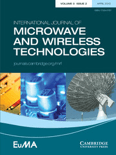
International Journal of Microwave and Wireless Technologies
Scope & Guideline
Empowering Research in Cutting-edge Wireless Technologies.
Introduction
Aims and Scopes
- Microwave Devices and Components:
Research on the design, fabrication, and characterization of microwave devices such as amplifiers, filters, antennas, and oscillators, emphasizing efficiency and performance. - Wireless Communication Systems:
Studies related to the design and optimization of wireless communication systems, including MIMO, cognitive radio, and 5G technologies, focusing on enhancing coverage and capacity. - Metamaterials and Advanced Materials:
Investigations into metamaterials and advanced materials for microwave applications, exploring their unique properties for antenna design and electromagnetic wave manipulation. - Microwave Imaging and Sensing Technologies:
Development of microwave-based imaging systems for medical and non-destructive testing applications, highlighting advancements in sensor technologies. - Electromagnetic Compatibility and Measurement Techniques:
Research on EMC issues, measurement techniques, and standards relevant to microwave and wireless technologies, ensuring device reliability and performance. - Machine Learning and AI in Microwave Engineering:
Integration of machine learning and artificial intelligence techniques in the design and optimization of microwave and wireless systems, enhancing predictive capabilities and performance.
Trending and Emerging
- 5G and Next-Generation Wireless Technologies:
Significant focus on research related to 5G technologies, including MIMO, beamforming, and advanced modulation techniques, as the demand for faster and more reliable wireless communication continues to grow. - Integration of AI and Machine Learning:
Emerging studies that incorporate AI and machine learning into microwave engineering for applications in design optimization, real-time monitoring, and predictive maintenance. - Flexible and Wearable Technologies:
Increasing interest in the development of flexible and wearable microwave devices, addressing the need for innovative applications in healthcare, fitness, and consumer electronics. - Advanced Antenna Systems:
Research on complex antenna systems, such as reconfigurable antennas and those utilizing metamaterials, is gaining traction due to their potential for improved performance and versatility. - Microwave Imaging Techniques:
Growing exploration of microwave imaging technologies for medical diagnostics and security applications, highlighting advancements in sensor design and data processing methodologies.
Declining or Waning
- Analog Microwave Circuits:
Research on traditional analog microwave circuits has diminished, possibly due to the shift towards digital and software-defined solutions that offer greater flexibility and performance. - Basic Microwave Theory:
Fundamental theoretical studies in microwave engineering have been less frequent, as the field increasingly prioritizes applied research and practical implementations. - Conventional Antenna Designs:
Standard antenna designs and methodologies are becoming less prominent, with more focus shifting to innovative and complex antenna systems that incorporate advanced materials and technologies. - Passive Components:
The study of passive components in microwave circuits, such as resistors and capacitors, appears to be waning as more attention is directed towards active components and integrated systems. - Traditional Filter Designs:
Research on conventional filter designs has declined, as the field moves towards more complex and adaptive filtering techniques that utilize advanced algorithms and materials.
Similar Journals
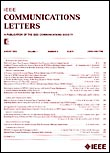
IEEE COMMUNICATIONS LETTERS
Pioneering Insights in Engineering and SimulationIEEE Communications Letters, published by the esteemed IEEE - Institute of Electrical and Electronics Engineers, is a leading journal in the fields of Computer Science Applications, Electrical and Electronic Engineering, and Modeling and Simulation. Since its inception in 1997 and continuing through to 2024, this journal has consistently ranked in the prestigious Q1 quartile across its categories, reflecting its high quality and substantial impact in the academic community. With an impressive Scopus rank, particularly standing at #24 in Mathematics - Modeling and Simulation, the journal serves as an essential resource for researchers, professionals, and students eager to stay at the forefront of innovative communications technologies. Although it does not offer open access, the journal ensures rigorous peer review and publication of concise, impactful articles that push the boundaries of research and application. Whether you’re involved in theoretical developments or practical implementations, IEEE Communications Letters provides critical insights that shape the future of engineering and technology.

Advances in Radio Science
Advancing Knowledge in Electrical EngineeringAdvances in Radio Science, published by COPERNICUS GESELLSCHAFT MBH, is a leading open-access journal established in 2003, dedicated to the rapid dissemination of high-quality research in the field of radio science, particularly focusing on advancements in electrical and electronic engineering. With an ISSN of 1684-9965 and an E-ISSN of 1684-9973, this journal is indexed and provides an avenue for researchers to contribute to the latest developments and innovations within the domain. Despite its current Q4 ranking in the Electrical and Electronic Engineering category, its commitment to open access ensures that all published articles are freely available to a global audience, fostering collaboration and knowledge sharing among engineers, researchers, and students alike. Situated in Göttingen, Germany, the journal continues to evolve and expand its reach, with content converging until 2024, emphasizing its relevance in a rapidly changing technological landscape. Whether you're a seasoned researcher or an emerging scholar, Advances in Radio Science invites you to explore the frontiers of radio science and contribute to its growing body of knowledge.
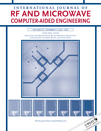
INTERNATIONAL JOURNAL OF RF AND MICROWAVE COMPUTER-AIDED ENGINEERING
Pioneering Research in RF and Computer-Aided EngineeringInternational Journal of RF and Microwave Computer-Aided Engineering, published by Wiley, is a leading peer-reviewed journal dedicated to advancing research in the realms of radio frequency, microwave engineering, and computer-aided design. With an ISSN of 1096-4290 and an E-ISSN of 1099-047X, this journal plays a pivotal role in the dissemination of innovative methodologies and state-of-the-art developments within these dynamic fields. Recognized within the Q3 category across three engineering and computer science domains as of 2023, it garners attention for its substantial contributions, ranking 40th among 106 in Computer Graphics and Computer-Aided Design and 327th among 797 in Electrical and Electronic Engineering according to Scopus metrics. Emphasizing its commitment to knowledge sharing, the journal provides a range of access options, including Open Access, to ensure the research is readily available to a global audience. Covering years from 1996 to 2024, the International Journal of RF and Microwave Computer-Aided Engineering continues to be an indispensable resource for researchers, professionals, and students in pursuit of excellence in engineering and applied sciences.

Progress in Electromagnetics Research-PIER
Advancing the Frontiers of Electromagnetic ResearchProgress in Electromagnetics Research-PIER, published by EMW PUBLISHING, is an esteemed academic journal that stands at the forefront of the fields of Condensed Matter Physics, Electrical and Electronic Engineering, and Radiation. With an impressive impact factor reflected in its Q1 quartile rankings across these disciplines, PIER serves as a critical platform for disseminating high-quality research findings and advancements from 2000 onwards, with the latest contributions expected through 2024. The journal's commitment to excellence is evident as it holds prominent positions in Scopus rankings, including a remarkable 95th percentile in the field of Radiation. Researchers, professionals, and students will find PIER invaluable for accessing cutting-edge topics and methodologies that push the boundaries of electromagnetics research. For facile access, the journal is published in both ISSN (1070-4698) and E-ISSN (1559-8985) formats, ensuring that vital knowledge is readily available to its audience.
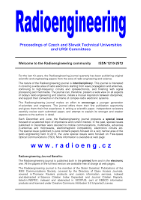
Radioengineering
Connecting scholars to cutting-edge research in radioengineering.Radioengineering is a prominent academic journal published by SPOLECNOST PRO RADIOELEKTRONICKE INZENYRSTVI, focusing on the fields of electrical and electronic engineering. Established in 1992, this open access journal aims to disseminate high-quality research and innovative developments in radioengineering and related disciplines. With an inclusive readership from around the world, it has been integral in fostering advancements in technologies such as wireless communication, signal processing, and electromagnetic theory. The journal's commitment to accessibility is underscored by its open access policy, allowing scholars and practitioners to freely engage with the latest findings. As of 2023, *Radioengineering* holds a Q3 quartile ranking in its field with a Scopus rank of #500/797, placing it within the 37th percentile among its peers. Researchers, professionals, and students engaged in electrical and electronic engineering will find *Radioengineering* an essential resource for both theoretical insights and practical applications. For further information, submissions, and access to articles, please visit the journal’s site linked through the CZECH TECHNICAL UNIVERSITY, located in Prague, Czech Republic.
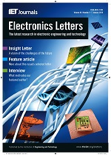
ELECTRONICS LETTERS
Advancing Knowledge in Electrical Engineering.ELECTRONICS LETTERS, published by WILEY, is a leading peer-reviewed journal dedicated to the field of Electrical and Electronic Engineering. With a rich history dating back to 1965, this journal serves as a prominent platform for disseminating novel research and innovations in electronics, covering topics such as circuit design, telecommunications, and signal processing. In 2021, the journal transitioned to an Open Access format, ensuring that cutting-edge research is freely accessible to a global audience, thereby enhancing its impact and outreach. The journal currently holds a Q3 quartile ranking in its category, reflecting its solid position among its peers, and ranks #451 out of 797 in Scopus for Electrical and Electronic Engineering, placing it within the 43rd percentile. ELECTRONICS LETTERS is essential for researchers, professionals, and students looking to stay abreast of the latest developments and contribute to advancements in the field, fostering collaboration and knowledge sharing in a rapidly evolving landscape.

IEEE Microwave and Wireless Technology Letters
Empowering discoveries in microwave and wireless technologies.IEEE Microwave and Wireless Technology Letters is a pivotal journal dedicated to the rapid dissemination of original research and innovative developments in the realms of microwave and wireless technologies. Published by the esteemed IEEE-INST ELECTRICAL ELECTRONICS ENGINEERS INC, this journal facilitates open access to its content, ensuring that cutting-edge findings are readily available to a global audience. With a focus on high-impact research and practical applications, the journal covers a broad spectrum of topics including but not limited to microwave circuit design, wireless communication systems, and advanced materials for radio-frequency applications. As of 2023, the journal has achieved notable rankings within the Scopus database, boasting a rank of #105 in Condensed Matter Physics and #208 in Electrical and Electronic Engineering, placing it in the top quartiles of both fields. This combination of vibrant research and accessibility positions IEEE Microwave and Wireless Technology Letters as an essential resource for academics, industry professionals, and students striving to advance their knowledge in this rapidly evolving field.
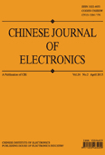
CHINESE JOURNAL OF ELECTRONICS
Driving Innovation in Electrical and Electronic EngineeringThe CHINESE JOURNAL OF ELECTRONICS is a distinguished peer-reviewed publication in the fields of electrical and electronic engineering and applied mathematics, published by the reputable IEEE-Institute of Electrical and Electronics Engineers Inc. Based in the United States, this journal has been a significant platform for sharing innovative research since its inception in 1996. With a commendable impact factor, it is ranked Q3 in both applied mathematics and electrical engineering categories, reflecting its relevance and quality within the academic community. The journal aims to disseminate high-quality research, foster interdisciplinary approaches, and provide a forum for discussions on advancements and applications in electronics and associated fields. Although it currently does not offer open access, the CHINESE JOURNAL OF ELECTRONICS remains a key resource for researchers, professionals, and students seeking to stay at the forefront of technological developments. Its Scopus rankings—170th in applied mathematics and 365th in electrical engineering—highlight its credibility and importance in advancing knowledge and innovation.
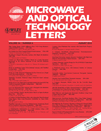
MICROWAVE AND OPTICAL TECHNOLOGY LETTERS
Fostering Innovation in Condensed Matter and BeyondMicrowave and Optical Technology Letters is a prestigious journal published by Wiley that serves as a vital platform for disseminating cutting-edge research in the fields of microwave and optical technology. Established in 1988, this journal has built a reputable presence, with its scope encompassing critical areas such as atomic and molecular physics, condensed matter physics, and electrical and electronic engineering. With a notable ranking in the Q3 quartile across multiple scientific categories, Microwave and Optical Technology Letters provides researchers, professionals, and students an invaluable resource to stay informed about the latest advancements and applications in these dynamic disciplines. Although the journal is not open access, its rigorous peer-review process ensures the highest quality of published content, contributing to an enriched academic dialogue. Researchers looking to enhance their knowledge in electronic, optical, and magnetic materials will find this journal particularly beneficial. For more information, please visit Wiley's official website or subscribe to stay updated on the latest volumes.
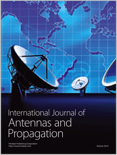
International Journal of Antennas and Propagation
Empowering researchers through open access knowledge.The International Journal of Antennas and Propagation, published by HINDAWI LTD, serves as a vital resource in the field of Electrical and Electronic Engineering, focusing specifically on advancements in antenna technology and propagation mechanisms. With an impact factor that reflects its academic rigor and relevance, this Open Access journal has been inviting submissions since 2007, ensuring that groundbreaking research is accessible to a global audience. Based in Egypt and distributed worldwide, the journal ranks in the Q3 category for Electrical and Electronic Engineering, situating it among the notable platforms for researchers seeking to disseminate their findings or stay abreast of the latest developments. It encompasses a wide scope, welcoming contributions that span theoretical studies, design innovations, and experimental validations, thereby fostering a comprehensive understanding of the subject. As it converges through the years from 2010 to 2024, the International Journal of Antennas and Propagation is a cornerstone for both emerging scholars and seasoned professionals aiming to enhance their knowledge and contribute to this dynamic field.